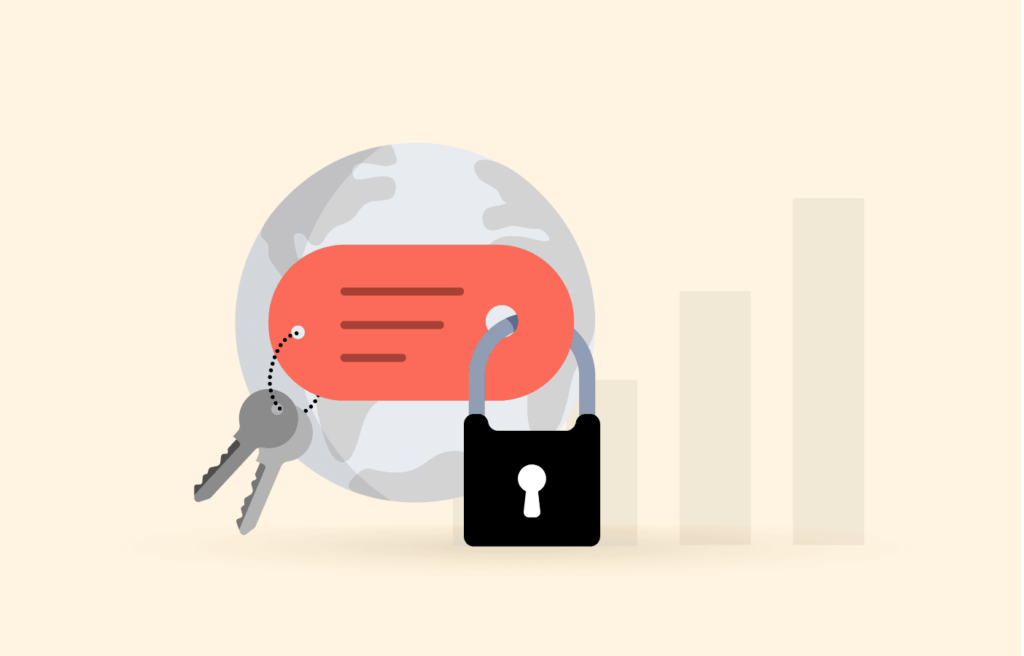If you want to legally watch “Family Guy,” “The Cleveland Show,” and “Game of Thrones,” you’ll have to subscribe to streaming services like Disney+ and Netflix. Of course, this would increase your monthly expenses. So, it’s unsurprising that people try illegal methods to access online content for free.
The global film industry incurs about $50 to $100 billion loss due to internet piracy.
So, before downloading another pirated content, look at the online piracy statistics we’ve gathered. You might find it intriguing to know how much piracy is present in everyday life.

Top 20 piracy statistics: Key findings (Editor’s pick)
- Pirated videos get over 220 billion views annually.
- The USA is the world leader in piracy, with over 13.5 billion visits to piracy sites.
- 34 percent of the Gen Z generation use stream-ripping.
- In 2021, there were about 180 billion visits to pirate sites worldwide.
- Many countries still use unlicensed software at a rate of 50 percent.
- China ranked first for the use of pirated software in 2021.
- The USA loses $12.5 billion yearly due to music piracy.
- By 2021, television piracy accounted for 50.3 percent of total piracy.
- There were 17 million stream-rippers in the USA in 2018.
- Every year, viewers illegally download or watch approximately 127 billion episodes of US TV shows.
- Western Europe and North America host 67 percent of all pirate sites.
- 57 percent of computer users admitted to downloading pirated software at least once in Eastern/Central Europe and the Asia Pacific regions.
- Google, Facebook, and Amazon paid pirated operations about $100 million in 2020.
- Pornography is the most pirated content.
- The millennial generation has the highest likelihood of book piracy.
- In 2022, the US online TV and movie industry had a projection to lose $11.58 billion to piracy.
- On average, it takes 234 days to detect a malware attack, costs $2.4 million, and is resolved 50 days after discovery.
- During the COVID-19 pandemic in 2020, the USA ranked high on the list of countries with 12.5 billion visits to pirate sites.
- Due to digital video piracy, America’s distribution and content sector suffers annual losses of $29.2 to $71 billion.
- Illegal streaming services account for over 80 percent of global online piracy.
What is piracy?
Piracy is the illegal copying or distribution of protected content via the Internet. It also describes the unauthorized reproduction, theft, storage, copying, and sale of any intellectual property (IP). Therefore, you’re pirating when you stream content from popular free sites like AZMovies or 123Movies. That’s because you download without authorization or make illegal copies of movies, electronic books, games, and software. It is an infringement on the content’s owner’s copyright.
Any sale of an unauthorized copy is a potential loss for the content owner. Take, for example, music piracy. You see a pirate operator site that allows you to download songs that it stole from a music streaming app for free. Undoubtedly, this deal is better than paying about $100 a year for songs. What’s not to like?
However, downloading content from the piracy site deprives the creative industry, music streaming apps, and artists of revenue. With time, their losses will run into billions of dollars and affect job creation in the creative industry.
What are the most common sources of online piracy?
What source comes to mind when you think of downloading content without paying? Of course, streaming sites would be the first to pop up. But there’s more to piracy than streaming sites.
Here are the most common sources of piracy:
1. Free streaming sites
Pirates usually download movies and upload them on streaming sites that the masses use to allow users to watch copyrighted content for free. If you’re downloading or watching movies from a website and multiple ads and pop-ups appear on your screen, you’re accessing a streaming site.
These sites have numerous malware that can maliciously attack your device and steal information. This goes without saying that the pirated movies you watch aren’t actually “free.”
2. Cyberlockers and cloud service
Piracy also thrives through cloud services. Pirates can simply use legitimate services like Amazon Cloud Drive, Dropbox, and OneDrive to deliver content they copied illegally. Many cyberlockers require you to subscribe for as little as $10 per month, while others allow you to stream content for free.
Pirates can quickly start new accounts once cloud service businesses discover their cyberlockers. Look at how the US government shut down Megaupload, a popular cyberlocker, in 2012. However, the pirate easily launched a new service in New Zealand called Mega.
3. Online auction sites
Pirates use sites like eBay and Amazon to sell software applications. Piracy from online auction sites is fraudulent because the pirate sells you poor-quality software.

Don’t fret! You can prevent this scam by confirming if the software is original.
4. Peer-to-peer networks
Discussions about piracy are incomplete without mentioning Peer-to-peer (P2P) technology. Pirates use these networks to download and share copyrighted materials illegally. Torrent sites are the most popular examples of sites that host media and other files users can download using P2P technology. Users search and download files from others who share them on such websites.
Online piracy stats
Online piracy is a widespread issue that countries and organizations are trying to tackle. As of August 2022, data from MUSO shows a 21.9 percent increase in online piracy from 2021.
1. Highest visits to pirate sites per country.
You may ask what the impacts of piracy are and what it entails. The MUSO company deals with these inquiries daily.
It has tracked piracy rates per country across several media and analyzed the most interesting ones among them. Piracy visits per country from January to March 2022 were about 190 billion. Here are the major piracy statistics per country:
| S/N | Country | Billion visits |
|---|---|---|
| 1 | United States | 5,662,531,831 |
| 2 | Russia | 3,030,468,120 |
| 3 | India | 3,012,491,886 |
| 4 | China | 1,781,912,546 |
| 5 | France | 1,661,176,960 |
| 6 | Brazil | 1,535,220,650 |
| 7 | Canada | 1,426,969,459 |
| 8 | Japan | 1,407,387,558 |
| 9 | The United Kingdom | 1,393,668,469 |
| 10 | Indonesia | 1,354,359,755 |
Recent piracy stats show more than 50 percent of the above visits went to free streaming sites. Direct download sources and torrent search engines are common media for pirated content.
(Source: MUSO)
2. Following a court decision in 2020, people can’t access The Pirate Bay in the Netherlands.
This is a success story in the content creation industry. Major Dutch ISPs were able to block users from accessing pirated sites.
(Source: ITIF)
3. Google began deindexing pirated websites in 2021.
In other words, pirated websites will not show in Google search results. Countries like Brazil, the UK, France, Norway, and the Netherlands took similar measures.
(Source: TorrentFreak)
4. There were 182 billion global visits to pirate websites in 2021.
Comparing the global stats of the previous year, which recorded over 130 billion visits, there was a 15 percent increase in 2021. This includes visits to publishing, TV, music, and movie sites. Stats also show that 62 percent of internet users visited pirate sites directly, and over 28 percent accessed them via search engines.
(Source: MUSO)
5. The United States ranks number one in piracy, with about 13.5 billion visits to pirate sites in 2021.
Russia ranks second with 7.2 billion visits, followed by India with 6.5 billion visits, and China comes third with 5.9 billion visits. These stats were for the first nine months of 2021.
(Source: Akamai)
6. Netflix’s anti-piracy team ensures content protection.
Netflix’s anti-piracy team protects the original content it creates every hour. This reduces the number of films and series available on piracy platforms. Netflix is also a member of powerful anti-piracy global organizations like the Motion Picture Association and Alliance For Creativity and Entertainment.

7. Major Fortune 500 companies paid $100 million for advertisements on pirate operators in 2020.
What a discovery! Would you have ever imagined that big brands pay pirate operators advertising revenue?
Findings show that major tech companies like Facebook, Google, and Amazon make up about three-quarters of all Fortune 500 company ads on pirate apps. This means these companies support piracy operators with potentially tens of millions of dollars.

Music piracy statistics
8. Music piracy accounted for 8.15 percent of all piracy in 2021.
According to MUSO, unlicensed streaming sites accounted for 31.5% of all music piracy visits in 2021, while illegal downloads made up 24.3%. Public and Private torrents accounted for the remaining 5%. No wonder you ever used PirateBay or its alternatives knowingly or unknowingly.
(Source: MBW)
9. Stream-ripping sites accounted for 39.2 percent of all music piracy globally in 2021.
Have you ever wondered how people pirate music? Well, it’s through stream-ripping. Stream-ripping involves illegally converting music files on streaming sites to downloadable copies.
And we’re talking about using streaming sites like Apple Music, Spotify, or YouTube. In 2020, stream-ripping sites accounted for about 33.9 percent of music piracy.
(Source: MusicWatch)
10. In 2019, India was the leading country in music piracy.
MUSO’s global piracy data reveal that India has the most unlicensed web downloads and streaming of music piracy in the market. Iran comes second, followed by the United States in third place.
(Source: Music Plus)
11. 27 percent of music listeners accessed unlicensed music in 2019.
Internet pirated content statistics revealed that 27 percent of people listened to pirated music in 2019. This was a 10 percent drop from the year 2018.
(Source: DJMag)
12. The average teen’s iPod had about 800 pirated, illegally downloaded, songs in 2008.
As far back as 2008, people between the ages of 13 to 25 had about 800 pirated audio on their iPods. And the average digital music player carries 1,770 music files. Shocking right?
According to the University of Hertfordshire study, many youngsters are willing to share all the music on their MP3 players and iPods, simultaneously passing on hundreds or thousands of songs.
(Source: The Times UK)
13. The UK experienced a 1390 percent increase in using stream-ripping services between 2016 and 2019.
PRS for music discovered a massive surge in the UK’s illegal online music activities. More than 80 percent of the leading 50 piracy websites specialize in stream-ripping.
(Source: PRS for music)
14. 83 percent of UK adults with pirated music did so because they had no paid options.
Is it against the law to download songs and other music from YouTube? MUSO asked this question to over 1000 UK adults in a poll. Half of those surveyed admitted to illegally accessing music at one time or another. More than 83 percent said they had first attempted to find the content through legal sources.
As a response to the question, “Is it against the law to download music?” The respondents said the following reasons led them to obtain music illegally.
- 34.9 percent of them blamed the unavailability of music on subscription channels.
- 35.2 percent received content illegally because it was free.
- 34.7 percent mentioned that some music was not available in their location.
(Source: MBW)
15. Music piracy dropped by 65 percent between 2017 and 2021.
Music piracy has declined consistently year-on-year from January 2017 to 2021. When you compare the Q4 of 2021 with Q4 of 2020, you’ll notice an 18.6 percent increase in music piracy. These results are from stream-ripper sites that allow you to rip and download YouTube audio.
(Source: MBW)
16. RIAA won $83 million in piracy damages from YouTube Rippers.
RIAA (Recording Industry Association of America) won a multimillion-dollar settlement in its piracy lawsuit against 2conv.com and FLVTO.biz. These stream-rippers allowed users to download YouTube content previously blocked in the US.
(Source: Forbes)
Movie piracy statistics

17. The most pirated TV show is “Game of Thrones.”
Piracy facts like this shouldn’t shock you, especially if you’re a GOT fan. Within 24 hours, consumers pirated the GOT final season premiere over 54 million times. Other highly pirated TV shows include “My Hero Academy,” “Rick and Morty,” “SpongeBob SquarePants” and “The Walking Dead.”
(Source: USwitch)
18. Pirated videos get over 230 billion views a year.
Latest piracy stats reveal that new TV shows are the next best thing to pirate. They have over 12.8 billion views in the US and 170.6 billion views globally.
19. Globally, over 80 percent of online piracy occurs through illegal streaming services.
More than four-fifth of online piracy activities are attributable to illicit streaming websites.
(Source: GIPC, NERA Economic Consulting)
20. People who pirate downloads are a whopping 28 times more likely to infect their devices with malware.
It’s not surprising that many pirate sites have malware-infected files. You may have never downloaded a movie illegally, but you have probably collected movies from people who do.
According to film piracy statistics, you can infect the device you use for piracy with malware. Therefore, it compromises your personal information and puts you at risk of identity theft. Watching pirate movies may no longer seem exciting when you consider this.
(Source: Digital Citizens Alliance)
21. In 2021, television piracy accounted for 50.3 percent of total piracy traffic.
When discussing television piracy, we mean watching live sports, soap operas, and anime series on manga sites. In 2021, TV piracy sites experienced a boom. They had over 91.6 billion visits, around 13.2 percent more than in 2020.
(Source: MUSO)
22. The global movie industry annually loses between $40 and $97.1 billion from digital piracy.
According to statistics for film piracy, the movie industry has a revenue loss between $40 and $97.1 billion. Meanwhile, the range is $39.3 to $95.4 billion for the TV industry.
(Source: GIPC, NERA Economic Consulting)
Software piracy statistics
23. The software industry had the least increase in piracy in 2021.
MUSO measured the Q1 of 2022 and recorded a 9.6 percent increase in the software piracy rate. Meanwhile, the film industry experienced a 42.5 percent increase, while TV content experienced an increase in piracy by 19.2 percent.
(Source: MUSO)
24. On average, it takes 243 days for organizations to detect an unlicensed software product.
This is a significant reason for you to stop downloading unlicensed software. According to the 2019 pirated software statistics, the higher the rate of unlicensed software products, the higher the possibility of you experiencing a malware attack. In addition, it takes up to 50 days to resolve the problem, costing $2.4 million.
(Source: BSA: The Software Alliance)
25. Asia-Pacific region exhibited the highest content piracy in 2017.
Despite global regulations and digital piracy fines, Asia had the highest piracy rates for unlicensed software in 2017.
According to a BSA study, Bangladesh was the top country with a rating of 84 percent, followed by Indonesia and Pakistan with 83 percent. What’s surprising about this stat is that Japan had the lowest rate of software piracy, accounting for 16 percent.
(Source: BSA: The Software Alliance)
26. Many countries still have 50 percent or above unlicensed software rates.
Every time you download software from a pirated operator, the copyright holder loses profit. Countries that understand the risk of unlicensed software have a low rate, while those who ignore software piracy have a rate of 50 percent or higher.
(Source: BSA: The Software Alliance)
27. By 2025, China’s piracy software rate may be as high as 69 percent.
China uses unlicensed software at an alarming rate. The projection for Russia is 58 percent.
(Source: Statista)
28. Most visitors to software pirate sites are from China in 2021.
When you talk about software piracy, China is a major player. Here, pirated software dominates the market. As you would expect, Russia and the United States follow China. Pirated software increased by 13 percent worldwide in 2021 and had its highest traffic from China.
(Source: MUSO)
29. Two of every five software copies people download are unpaid.
Pirated software statistics show that two out of every five software copies people download worldwide are free. Unfortunately, the more expensive your software is, the more likely people would choose the pirated version. It seems like this is an unsaid rule about downloading software.
(Source: Revenera)
Book piracy statistics

30. People between the ages of 30 and 34 are more likely to pirate books.
Book piracy is an emerging market that you’re likely to normalize. How many ebook sites have you subscribed to? Even when you subscribe, you’re often willing to share these books with other readers.
In 2017, there were over 16.5 million illegal book downloaders in the United States alone. While music and movie piracy are popular among youngsters, book piracy is prevalent within the 30-44 age bracket.
(Source: Statista)
31. 4shared.com is the most used pirate book site in the USA.
Piracy statistics reveal that over 50 percent of respondents use 4shared.com, a popular file-sharing site, to access ebooks. Many readers use this well-known book-sharing site to download ebooks illegally. Other choices for pirated books include Books.org and Uploaded.net.
(Source: Statista)
32. American publishers lose $300 million every year to piracy.
Ebook piracy doesn’t seem to decrease any time soon. The numbers keep getting higher annually. Aside from the United States, publishers worldwide lose thousands of dollars in earnings due to internet piracy.
(Source: Forbes)
33. Demand for Manga increases piracy for books by 18.3 percent.
The publishing sector is experiencing the largest growth in piracy due to the demand for Manga. Comparing Q1 of 2022 with Q1 of 2021, there has been an 18.3 percent increase in ebook piracy. Besides, three out of the top five piracy websites by visits are for manga content.
(Source: MUSO)
Demographic profile of pirates
34. In comparison with other generations, millennials normalize piracy the most.
The millennial generation is taking piracy to a new level. Since they download torrents online, it’s not surprising that they’re clamoring for more mainstream tolerance for piracy. Many millennials have a pro-sharing attitude.
(Source: Red Points Solutions)
35. The piracy rate among children between 12 to 17 in Australia has increased.
Current pirated content statistics reveal that 31 percent of children living in Australia enjoy pirating movies.
(Source: Red Points Solutions)
36. The United States has the highest global piracy demand.
The US has the highest global piracy demand in Q1 2022. This equates to 10.9 percent of all traffic, with 5.7 billion visits to piracy websites and a growth of 1.6 billion in Q1 2021.
(Source: MUSO)
37. 44.44 percent of college-age men view online piracy favorably.
Of course, anyone can pirate content, but men seem to see the act more positively, according to a 2012 survey. Nonetheless, 14.62 percent of female students also have a similar opinion.
(Source: University of Southern Mississippi)
How to prevent piracy
As we explained in the section about the most common sources of piracy, realizing that you’ve accessed pirated content may not be so obvious. If you’re nonchalant, it could attract legal consequences. We sincerely hope it never gets to this.
1. Avoid peer-to-peer networks
When you use P2P technology, you materially aid pirates even when you don’t download or upload content. It’s best not to use peer-to-peer services like qBitTorrent and uTorrent because they can store pirated software on your PC without your knowledge.
2. Don’t download music from free sites
Don’t also bother streaming music on free sites. There’s the saying, “Nothing is free, even in Freetown.” Most of these sites expose your device to viruses. Stick to popular and legal music streaming services like Apple Music, Spotify, SoundCloud, Pandora, Tidal, and 8Tracks.
3. Use reputable sources
If a website seems suspicious, it’s probably suspicious. You can easily notice the disparity between questionable and reputable sources. Always trust your instincts.
4. Use parental controls
Especially when you have children, you should use parental control on their devices to limit the websites they can access.
FAQs
According to the latest piracy statistics, people download over 1.2 billion songs yearly.
MUSO, a company that tracks piracy trends, found over 300 billion visits to pirate websites in 2017 alone. Piracy has spread to every form of digital content imaginable.
Recent piracy statistics show that TV shows in the US are the most pirated content, with 126.7 billion views.
Piracy leads to millions and billions of dollars in global revenue losses. US citizens lose about 70,000 jobs a year due to music piracy.
